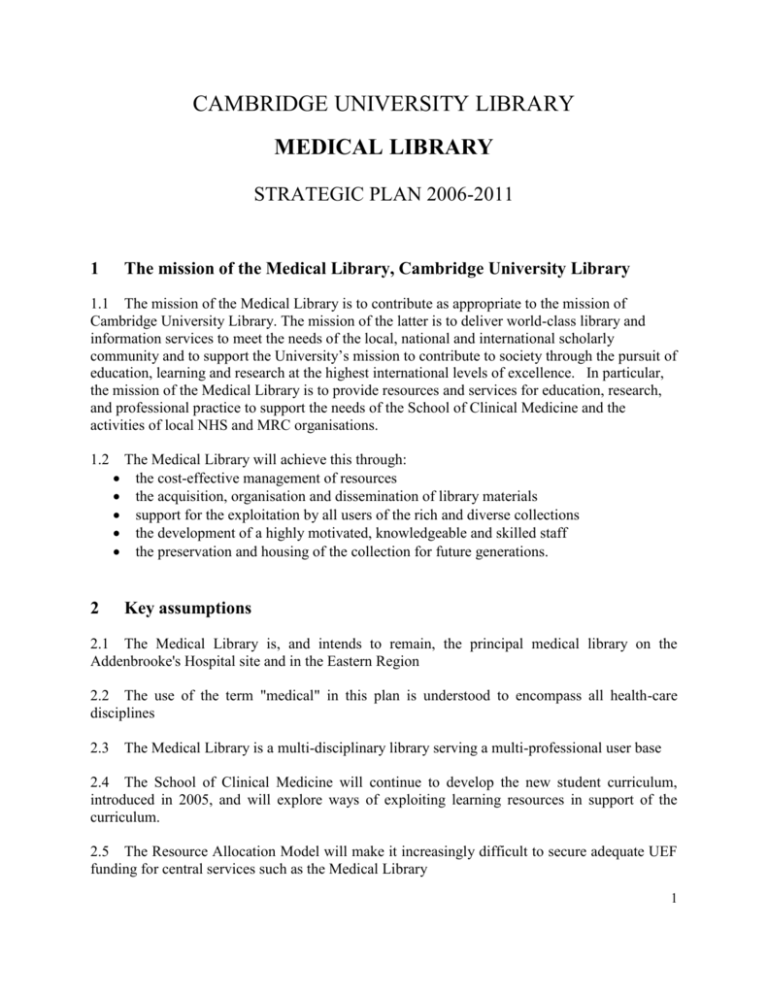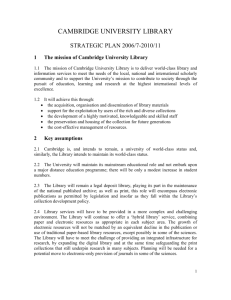Medical Library Strategic Plan
advertisement

CAMBRIDGE UNIVERSITY LIBRARY MEDICAL LIBRARY STRATEGIC PLAN 2006-2011 1 The mission of the Medical Library, Cambridge University Library 1.1 The mission of the Medical Library is to contribute as appropriate to the mission of Cambridge University Library. The mission of the latter is to deliver world-class library and information services to meet the needs of the local, national and international scholarly community and to support the University’s mission to contribute to society through the pursuit of education, learning and research at the highest international levels of excellence. In particular, the mission of the Medical Library is to provide resources and services for education, research, and professional practice to support the needs of the School of Clinical Medicine and the activities of local NHS and MRC organisations. 1.2 2 The Medical Library will achieve this through: the cost-effective management of resources the acquisition, organisation and dissemination of library materials support for the exploitation by all users of the rich and diverse collections the development of a highly motivated, knowledgeable and skilled staff the preservation and housing of the collection for future generations. Key assumptions 2.1 The Medical Library is, and intends to remain, the principal medical library on the Addenbrooke's Hospital site and in the Eastern Region 2.2 The use of the term "medical" in this plan is understood to encompass all health-care disciplines 2.3 The Medical Library is a multi-disciplinary library serving a multi-professional user base 2.4 The School of Clinical Medicine will continue to develop the new student curriculum, introduced in 2005, and will explore ways of exploiting learning resources in support of the curriculum. 2.5 The Resource Allocation Model will make it increasingly difficult to secure adequate UEF funding for central services such as the Medical Library 1 2.6 Appropriate levels of funding through appropriations in aid from the MRC and, especially, from the NHS will be essential if the Medical Library is to maintain an adequate level of service to all users. 2.7 Library services will have to be provided in a more complex and challenging environment. The growth of electronic resources will not completely replace the use of traditional paper-based library resources; the Library will have to meet the challenge of an integrated approach to the provision of an infrastructure for research by expanding the digital library and at the same time safeguarding those print collections that are still an important resource for some users. 2.8 Developments in ICT will allow more sophisticated services to be offered, and the growth in computer literacy and widespread use of PCs and laptops by all groups of user will lead to expectations for more and more library services to be delivered directly to the desktop. 2.9 Inflation in the costs of materials, especially scientific journals, will continue to exceed any growth in the Library’s income. 2.10 The University Library will remain a legal deposit library, and the Medical Library will continue to house medical material received by legal deposit insofar as it is consistent with the Medical Library's collection development policy. 2.11 During the period covered by this plan, there will be increasing co-ordination between the University Library and the Medical Library, and between the Medical Library and other libraries both within and outside the University. 2.12 The Medical Library, while continuing to offer a ‘hybrid library’ service, will depend increasingly on electronic resources, maintaining print-based collections on a limited basis where the case for doing so can be explicitly justified. 2.13 Disposal of printed stock by relocation or other means will reduce the need for library shelving, thus releasing space for other facilities and activities. 3 Critical success factors 3.1 To be able to fulfil its mission and meet the demands of its users, the Medical Library must be adequately resourced, through a combination of a stable and predictable income from the UEF, appropriate funding from the NHS and MRC, increased income from trading activities and increased efficiency wherever possible. 3.2 Major risks to success 3.2.1 Reduction in UEF funding without an increase in external funding Impact: inability to provide core services, including adequate provision of books, journals and electronic resources 2 3.2.2 Imbalance between levels of NHS/MRC funding and use of the Medical Library by those user groups Impact: inability to maintain services to NHS and MRC user groups 3.2.3 Failure of the University Library to acquire sufficient additional storage in the West Road building Impact: inability to relocate historical medical material out of the Medical Library, with consequent inability to use/redeploy space effectively 3.2.4 Failure to raise substantial funding from external sources Impact: major storage crisis if Phase 6 extension is not started Impact: inability to develop new services and enhance access to resources 3.2.5 Failure to recruit and retain appropriately skilled and motivated staff Impact: inability to maintain and develop services 4 Strategic goals 4.1 To strengthen the collections 4.1.1 Continue to review and, if necessary, revise the Collection Development Policy to ensure an appropriate balance of acquisitions across subjects, in electronic and paper format, to meet the expressed needs of users and within the available budget. 4.1.2 Continue to liaise with other libraries to ensure optimum co-ordination of resources. 4.2 To enhance availability and accessibility of the collections and other information resources 4.2.1 Improve access to the collections via the online catalogue. 4.2.2 Improve accessibility of collections and resources by utilising the web to the full. 4.2.3 Continue to liaise with advisers representing Clinical School, NHS, and MRC interests to ensure that collection development and support services are appropriate to the needs of those user groups. 4.2.4 Continue to ensure that readers are provided with an appropriate level of guidance on the use of the Medical Library and its resources. 4.2.5 Consider changing the name of the Medical Library to reflect more accurately its evolving multi-professional role. 4.3 To optimise the environment for study and research 3 4.3.1 Refurbish the entrance area of the Medical Library. 4.3.2 Continue to develop the accommodation to facilitate use of both electronic and printed resources. 4.3.3 Restructure the staff working area to optimise operational working relationships and improve service provision to users. 4.4 To ensure that the collections are adequately housed and preserved 4.4.1 Ensure that appropriate storage is provided for the collections 4.4.2 Prepare and implement a preservation policy for all parts of the collections 4.4.3 Prepare and implement a stock disposal policy for the journals collection. 4.5 To ensure that an adequate technical infrastructure is in place 4.5.1 Ensure that readers and Medical Library staff are provided with appropriate hardware and software to access and manipulate the resources they need. 4.5.2 Improve stock security and access control by replacing the existing book security system 4.5.3 Improve the efficiency of the book issuing system and reduce staff workloads by installing a computer-based self-issue loan system. 4.5.4 Improve stock control and reduce staff workloads by installing a radio-frequency identification stock management system. 4.6 To develop partnership and collaboration 4.6.1 Exploit the potential for enhanced cooperation within the University. 4.6.2 Review the organisational and physical relationship with the Clinical School's IT Support Service and Clinical & Biomedical Computing Unit to ensure optimum integration of needs and resources. 4.6.3 Ensure that the services and resources of the Medical Library are effectively integrated with the resources to be offered by the National Library for Health 4.6.4 Continue to work with the Addenbrooke's NHS Trust to develop co-ordinated library and information resources for the Trust's workforce 4.6.5 Continue to work with other libraries within the University and within the NHS regionally 4 4.6.6 Continue to work with other libraries on a national and international basis through organisations such as the CILIP Health Libraries Group, the University Medical School Librarians Group, and EAHIL. 4.7 To ensure support from high quality staff 4.7.1 Implement the University’s HR strategy insofar as it affects Medical Library staff 4.7.2 In the light of new service demands and expected staff changes, ensure that staff are equipped with appropriate new skills to provide improved services and that the Medical Library has the most appropriate staff management structure 4.7.3 Improve awareness of health and safety issues among staff 4.8 To ensure that adequate resources are available to fulfil this plan 4.8.1 Ensure that the Library’s case for maximising its income from University sources is made and understood 4.8.2 Continue to work with the relevant NHS Strategic Authority to ensure that the Medical Library's collections and services are appropriately developed, co-ordinated, and funded. 4.8.3 Substantially increase the Library’s income from external sources 4.8.4 Consider new forms of income generation 4.9 Governance and quality assurance 4.9.1 Review the Library's governance structure to ensure that it can provide effective strategic and political guidance and represent the interests of all stakeholder groups. 4.9.2 Participate fully in NHS and other relevant library accreditation processes 4.9.3 Introduce and maintain appropriate means of assessing and improving the quality of services through performance indicators, user surveys, and other quality assurance processes Peter Morgan Medical Librarian (December 2006) 5






